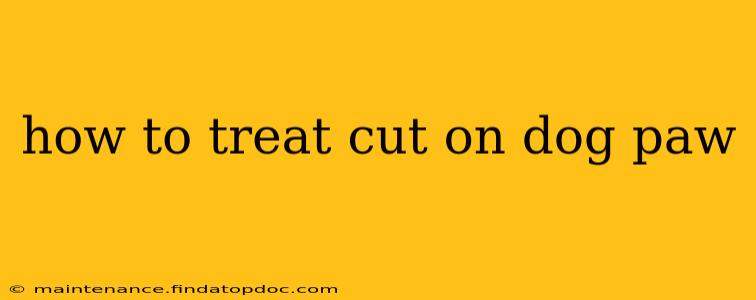A cut on your dog's paw can be distressing for both you and your furry friend. Knowing how to properly assess and treat the wound is crucial to prevent infection and promote healing. This guide will walk you through the steps to effectively care for your dog's paw injury. Remember, this information is for guidance only; if you are unsure about anything, always consult your veterinarian.
How Serious is My Dog's Paw Cut?
Before you begin treatment, it's important to assess the severity of the cut. Minor cuts may only require cleaning and monitoring, while deeper wounds need professional veterinary care. Consider these factors:
- Depth of the cut: A superficial scratch is different from a deep laceration that exposes muscle or bone.
- Bleeding: Minor bleeding is usually manageable at home, but significant or uncontrolled bleeding requires immediate veterinary attention.
- Location of the cut: Cuts on the paw pads are particularly vulnerable to infection due to constant exposure to dirt and debris.
- Signs of infection: Look for swelling, redness, increased pain, pus, or a foul odor. These are signs you need professional help immediately.
What Supplies Do I Need?
Having the right supplies on hand will make treating your dog's paw cut easier and more effective:
- Clean towels or gauze: For cleaning and drying the wound.
- Warm water: For rinsing the wound.
- Mild soap (unscented): For cleaning the wound. Avoid harsh chemicals.
- Antiseptic solution (e.g., diluted chlorhexidine or povidone-iodine): To disinfect the wound. Always follow the product instructions carefully.
- Clean bandage or vet wrap (optional): To cover the wound and protect it. Avoid using cotton balls, as they can stick to the wound.
- Pet-safe antibiotic ointment (optional): Consult your vet before using any ointment.
- E-collar or Elizabethan collar (optional): To prevent your dog from licking or biting the wound.
How Do I Clean and Dress a Dog's Paw Wound?
- Restrain your dog safely: Make sure your dog is calm and comfortable. A second person may be helpful to hold your dog. Never force your dog.
- Gently clean the area: Rinse the wound with warm water to remove loose dirt and debris. Use mild soap to gently clean the area around the wound, but avoid getting soap directly into the cut.
- Apply antiseptic: Carefully apply a small amount of antiseptic solution to the wound, following the manufacturer's instructions.
- Monitor for bleeding: Apply gentle pressure with a clean cloth if there is bleeding. If bleeding is excessive or doesn't stop, seek immediate veterinary care.
- Apply a bandage (if necessary): If the wound is deep or in a location where it's easily irritated, apply a clean bandage to protect it. Ensure the bandage isn't too tight.
- Check the wound regularly: Inspect the wound daily for signs of infection. Change the bandage as needed, keeping it clean and dry.
When Should I Take My Dog to the Vet?
It's crucial to seek professional veterinary care if:
- The bleeding is severe or doesn't stop.
- The wound is deep or exposes bone or muscle.
- You see signs of infection (swelling, redness, pus, foul odor).
- The wound doesn't show signs of healing after a few days.
- Your dog is showing signs of pain or discomfort.
- You are unsure how to treat the wound.
How Can I Prevent Future Paw Injuries?
- Keep your dog's nails trimmed: Long nails can make your dog more prone to paw injuries.
- Avoid walking your dog on rough terrain without proper paw protection: Dog boots can be a great way to protect your dog's paws.
- Be vigilant about hazards: Watch out for broken glass, sharp objects, and other potential hazards.
Remember, preventing injuries is always better than treating them. By taking precautions and knowing how to properly care for your dog's paws, you can ensure their safety and well-being. Always consult with your veterinarian for any concerns regarding your dog's health.
